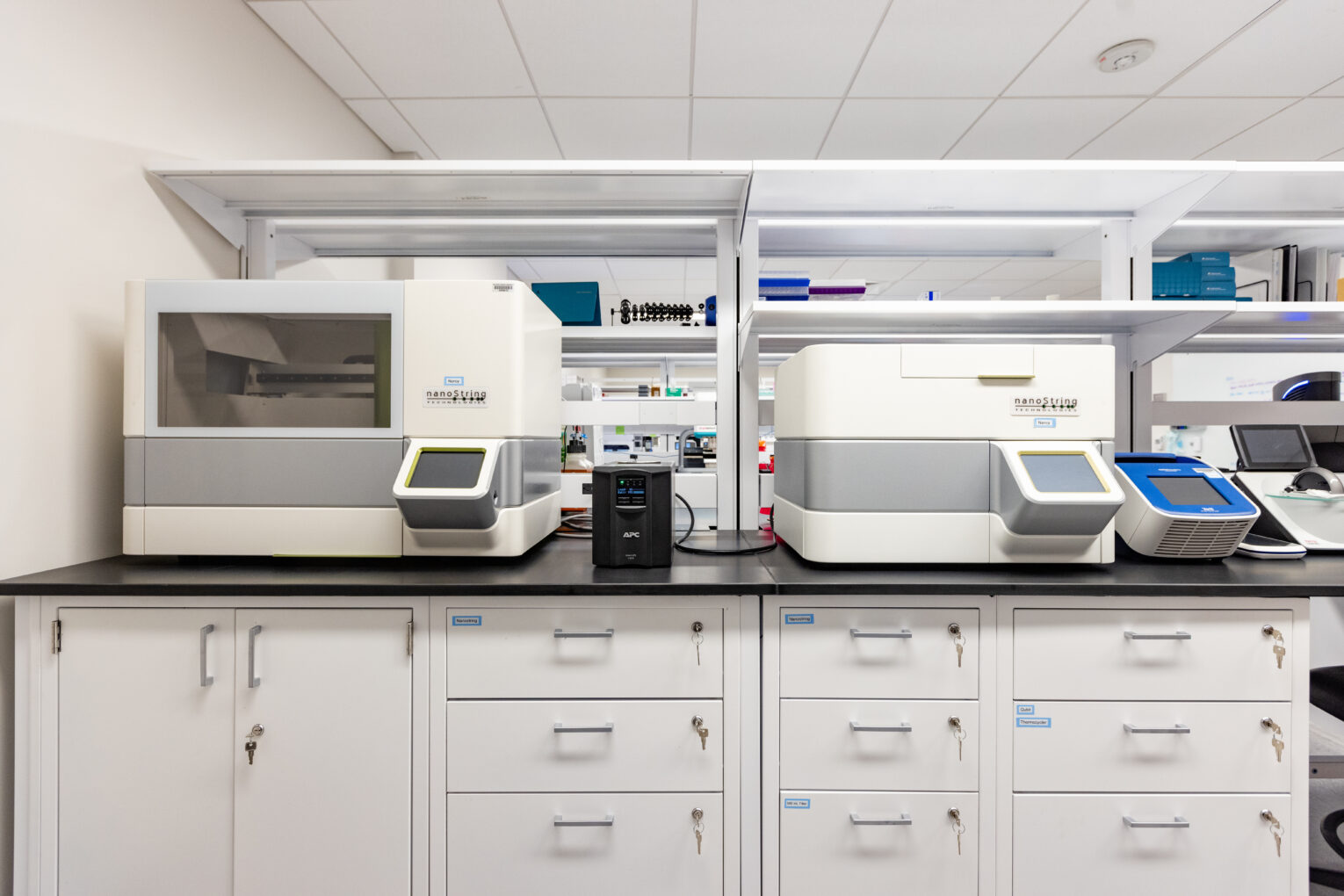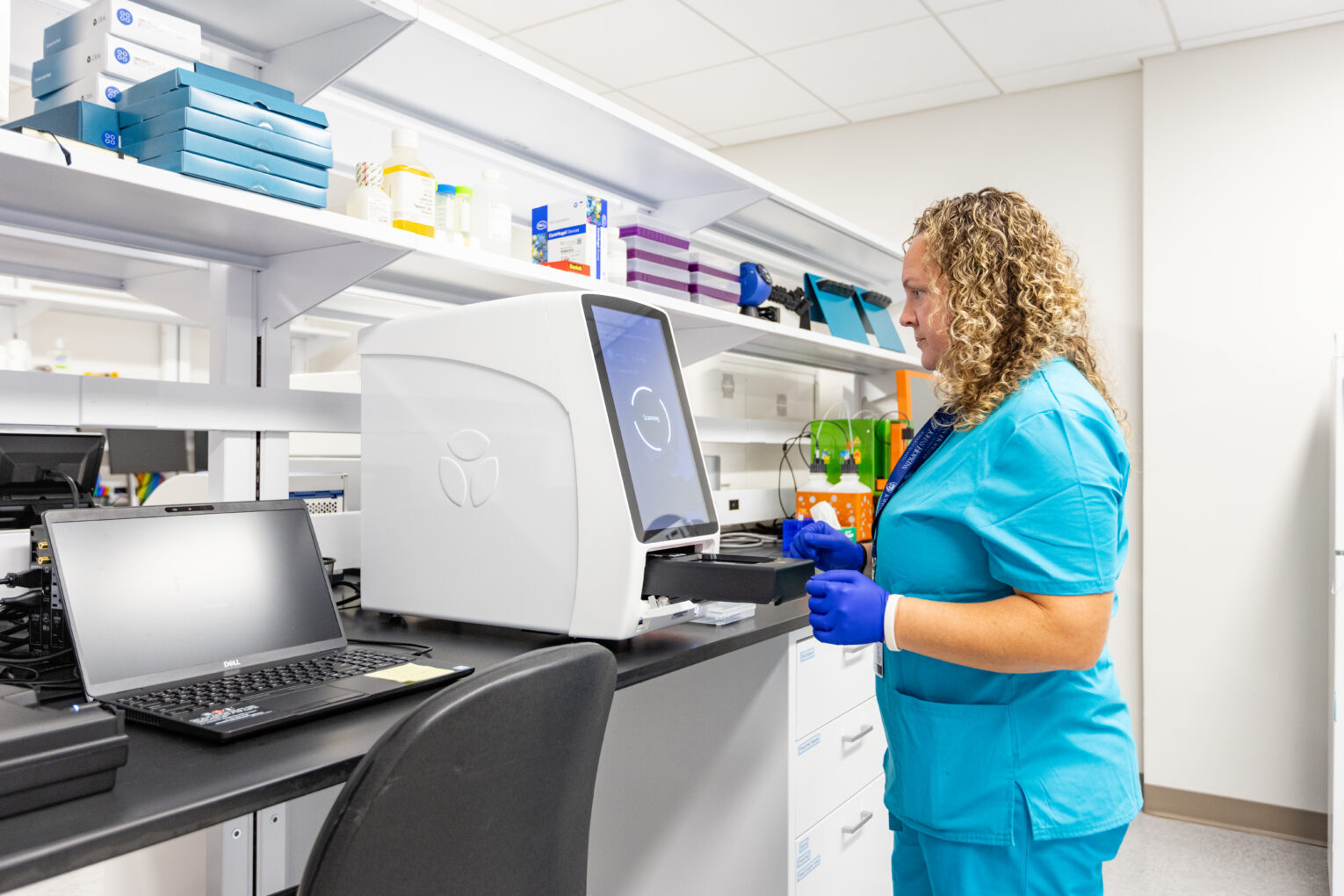PRECEDE Biomarkers Laboratory
Promoting Resilience through Emerging Clinical and Evolving Determinants of Equity (PRECEDE) Biomarkers Laboratory
Blood based biomarkers to be analyzed will be undertaken by Dr. Jessica Gill who is a Professor at Johns Hopkins University. Her laboratory is approximately 1,800 square and is located in the School of Nursing. In her laboratory there are 3 full-time investigators, including a laboratory manager, as well as up to 4 fellows each year. Her lab has all the necessary equipment to function as a molecular biological laboratory, including centrifuges, a biological safety cabinet, balances, freezers and refrigerators. Freezers for sample storage are under freezer monitory systems and are fully functional and available for study samples.
Overview of Services
Services provided are the Olink high-throughput proteomics platform and the available assays include Explore HT, Reveal, Target 48, Target 96, Flex, and Focus. Click the link to the ilab website for iquiry and more information.
Learn more about the PRECEDE Biomarkers Laboratory
Quanterix Technology
Dr. Gill uses Simoa technology, developed by Quanterix®, Inc., incorporating an array of femtoliter-sized reaction chambers that can isolate and detect single enzyme molecules, measuring very small amount of protein, which cannot be detected with regular ELISA system. The Simos HD-X Analyzer enables protein concentrations to be determined digitally rather than by using the total analog signal, called digital ELISA. By isolating and detecting single immunocomplexes in arrays of femtoliter-volume wells, digital ELISA enables clinically important proteins in plasma to be measured at sub-femtomolar concentrations that allows peripheral samples of blood to approximate central activity of neuropeptides. Recently, the Simoa technology, has allowed development of assays which provide a ~1000-fold improvement in sensitivity over traditional immunoassays in both a bead-based and planar assay system.

The SP-X is a next-generation Quanterix® Simoa Planar Array technology for robust multiplex circulating biomarker detection at the earliest stages of disease progression – even at healthy baseline levels. The Quanterix® SP-X Imaging and Analysis System is a complete benchtop system that has multiplex detection at both acute and baseline levels. This system allows for multi-plex assays of up to 10 cytokines within one sample, optimizing work-flow using high-resolution CCD camera with high efficiency lens, and a vortex interaction between analyte molecules and capture antibodies to provide high-sensitive assay data using proprietary high-precision digital nanofluidic antibody deposition technology.

Olink® Technology
Olink technology is a high-throughput proteomics platform that uses Proximity Extension Assay (PEA) technology to enable precise, multiplex protein biomarker analysis. By employing dual antibody binding and DNA-based detection, it offers high specificity and sensitivity, even in complex biological samples like plasma and serum. Olink’s applications span biomarker discovery, disease mechanism studies, and therapeutic development, with a focus on gaining insights into areas such as oncology, neurology, cardiovascular, and immunology. Its quantitative, reproducible data empowers researchers to identify and validate protein signatures across diverse disease states, advancing precision medicine and translational research.
Olink Signature Q100– uses up to 92 carefully selected proteins across 88 samples, using just 1 μL of serum, plasma, or almost any other type of biological sample, which helps bring new insights into disease processes, improve disease detection and contribute to a better understanding of biology. Each biomarker is addressed by a matched pair of antibodies, coupled to unique, partially complementary oligonucleotides, and measured by quantitative real-time PCR. This dual recognition, DNA-coupled method provides exceptional readout specificity, since unlike in many other immunoassay formats, any antibody cross-reactivity that may occur during the multiplexed assay is excluded from the detection process. Exclusive features of protein analysis using Olink® Signature Q100 together with Olink® Target, Flex, and Focus panels.
Olink’s Proximity Extension Assay (PEA) technology offers several unique benefits for biomarker discovery and proteomics, making it highly valued in clinical and research settings. Here are the key advantages:
- High Sensitivity and Specificity: PEA is highly sensitive, able to detect low-abundance proteins in complex biological samples. Its dual antibody-binding requirement (both antibodies need to bind to a target protein to trigger signal amplification) reduces non-specific binding and ensures high specificity.
- Broad Dynamic Range: Olink assays can detect proteins across a wide dynamic range (often 10 logs), which is essential in clinical research where both high- and low-abundance proteins are informative.
- Minimal Sample Volume Requirement: The technology requires only a small amount of sample (typically as little as 1 µL), preserving precious or limited samples for broader analyses or other uses.
- Multiplexing Capability: PEA can analyze hundreds (Target) or thousands (Explore) of proteins in parallel from the same sample, allowing researchers to get comprehensive protein profiles in a single run, which increases efficiency and reduces costs.
- Quantitative and Reproducible Data: PEA provides high-quality, quantitative data that is reproducible across experiments, making it suitable for longitudinal studies and cross-laboratory comparisons.
- Compatible with Standard Lab Equipment: The technology does not require highly specialized equipment; it works with standard real-time PCR instruments, making it accessible for many labs.
- Reduced Risk of Cross-Reactivity: Because two correct antibodies need to bind simultaneously to generate a signal, the risk of cross-reactivity is minimized, leading to more reliable results.
- Scalable for Clinical Use: Olink’s platform has been designed to scale, with applications for clinical biomarker discovery and the potential for diagnostic use, bridging research and clinical workflows.
These features make Olink’s PEA technology a powerful tool for high-throughput protein biomarker discovery, especially when working with small sample sizes or in studies requiring high sensitivity and specificity.
Additional Technology
The laboratory has the pipeline for the analyses of exosomes, and existing protocols for isolating exosomes from biological fluid, and an anti-body pull down of brain specific exosomes. Further, the lab is now able to use these methods to isolate microglial and astrocyte exosomes. Following isolation lysing, the contents are then evaluated on proteomic and genetic platforms within the lab such as the ExoView™ R200 and LabSpinner platforms. The ExoView™ R200 pulls together fluorescence imaging and single particle interferometry to provide complete characterization of exosomes. It is an automated platform that utilizes raw or purified samples, providing biophysical and proteomic information at the single-particle level. The LabSpinner ExoDiscovery instrument utilizes the lab on a chip into a lab on a disc miniaturized microfluidics into an automated fashion. The ExoDiscovery provides effective biomarker discovery using exosomes and similar extracellular vesicles from other bodily fluids.

Meso-Scale Diagnostic® (MSD) also has a platform available in her laboratory, the MESO-Quick Plex SQ 120MM. This instrument allows for high sensitivity assays to be undertaken, including candidates not available for assays on the Quanterix® Simoa platform systems. The MESO Quick Plex SQ 120MM employs an ultra-low-noise, CCD camera system and improved electronics for better performance. It features custom-designed telecentric lenses for rapid detection using all multi-array or multi-spot plates. The combination of rapid read times (90 seconds/plate) and the ability to process both 96-well and 384-well multiplex plates makes the MESO Quick Plex SQ 120MM ideal for assays of high volume.

Her lab has 4 different platforms to perform DNA and RNA analysis. Nanostring® can examine up to 798 micro-RNAs can be measured simultaneously in a single sample, and up to 12 samples can be assayed in a single run, which generates data that is consistently of very high quality. Nanostring® is and to evaluate DNA and RNA based on a target-based analyses and plates developed to identify or validate genetic markers. The nCounter Analysis System for Nanostring® provides data on various research involving miRNA analysis of biofluids to determine genetic pathways and gene functions within biofluids in reference to various biomarkers following injury. The nCounter miRNA Expression Panels utilize NanoString’s amplification-free technology to do expression profiling by direct quantification of individual RNA molecules. The assay detects miRNAs without the use of reverse transcription or amplification by using molecular barcodes.
In order to support the assay platforms undertaken in the lab, as well as sufficient quality control, the Gill lab has all required equipment such as Nanodrop and Qubit, an automated plate washer, plate shakers, thermocyclers, balances, ultrapure Millipore water system, and calibrated pipettes.

In the News
Trauma Translator: PhD Student Seeks Biomarkers in Vets’ RNA that Can Sound Alarm on Heart Disease
Questions
For questions about the PRECEDE Biomarkers Laboratory.
Chelsea Wagner
Director of the Clinical Translational Laboratory
[email protected]




